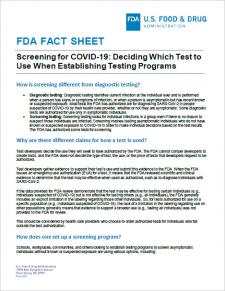Screening for COVID-19: Deciding Which Test to Use When Establishing Testing Programs
How is screening different from diagnostic testing?
- Diagnostic testing: Diagnostic testing identifies current infection at the individual level and is performed when a person has signs or symptoms of infection, or when a person is asymptomatic but has recent known or suspected exposure. Most tests the FDA has authorized are for diagnosing SARS-CoV-2 in people suspected of COVID-19 by their health care provider, whether or not they are symptomatic. Some diagnostic tests are authorized for use only in symptomatic individuals.
- Screening testing: Screening testing looks for individual infections in a group even if there is no reason to suspect those individuals are infected. Screening involves testing asymptomatic individuals who do not have known or suspected exposure to COVID-19 in order to make individual decisions based on the test results. The FDA has authorized some tests for screening.
Why are there different claims for how a test is used?
Test developers decide the use they will seek to have authorized by the FDA. The FDA cannot compel developers to create tests, and the FDA does not decide the type of test, the use, or the price of tests that developers request to be authorized.
Test developers gather evidence to support their test's use and submit this evidence to the FDA. When the FDA issues an emergency use authorization (EUA) for a test, it means that the FDA reviewed scientific and clinical evidence to determine that the test may be effective when used as authorized, such as to diagnose individuals with SARS-CoV-2.
If the data provided for FDA review demonstrate that the test may be effective for testing certain individuals (e.g., individuals suspected of COVID-19) but is not effective for testing others (e.g., all individuals), the FDA generally includes an explicit limitation in the labeling regarding those other individuals. So, for tests authorized for use on a specific population (e.g., individuals suspected of COVID-19), the lack of a limitation in the labeling regarding use on other populations generally means that evidence to support a broader use (e.g., testing all individuals) was not provided to the FDA for review.
This should be considered by health care providers who choose to order authorized tests for individuals who fall outside the test authorization.
How does one set up a screening program?
Schools, workplaces, communities, and others looking to establish testing programs to screen asymptomatic individuals without known or suspected exposure are using various options, including:
- Using a test authorized for screening.
- Health care providers on behalf of the program ordering an authorized diagnostic test for screening.
- When using a test that is not specifically authorized for screening, it is particularly important to understand what you know and don't know about the test's performance and combine it with other strategies, taking the following into consideration:
- Consider using a highly sensitive authorized test, especially if rapid turnaround times are available. If highly sensitive authorized tests are not feasible, or if turnaround times are prolonged, consider using a less sensitive authorized point-of-care test, such as an antigen test.
- Consider using a pooling strategy to conserve testing supplies. Several tests have been authorized for pooling.
- Consider frequent serial testing, such as the repeated use of rapid point-of-care or at-home tests for self-testing at a predetermined testing interval.
- Negative results should be considered as "presumptive negative," and health care providers should consider them in the context of clinical observations, patient history, and epidemiological information. If there is a concern that an individual with a negative antigen, other point-of-care or at-home test result may have COVID-19 (e.g., because of a new outbreak in a congregate setting), consider retesting the individual with a highly sensitive authorized molecular test.
- When using a test that is not specifically authorized for screening, it is particularly important to understand what you know and don't know about the test's performance and combine it with other strategies, taking the following into consideration:
Regardless of the test selected, it's important to monitor for updates from the FDA or the test developer for new information regarding the performance of the selected test with emerging mutations of the virus in your community. It is important to note that testing, even serial testing, is of limited value if it is not combined with appropriate mitigations for individuals who test positive (such as quarantine), good contact tracing, and effective behavioral protocols (such as mask wearing, hand washing and social distancing), even for individuals who test negative.

